Data analytics is an important investment for businesses. Understanding how the company performs right now and where it will be in one, five, or ten years is crucial in building an efficient development strategy and accelerating its growth.
According to recent research by Boston Consulting Group, the growth rate of data maturity has almost doubled since 2018.

However, analytics professionals and leaders often struggle with the strategy, implementation, and evaluation of their analytical efforts. In such cases, it becomes hard to determine whether the company is investing enough in analytics and whether these investments pay off.
Analytics maturity models are meant to solve this problem.
In this post, we'll dive into the concept of analytics maturity, break down all of the stages of analytics maturity, and figure out how to assess the maturity level of your organization.
The guide can be useful for both for-profit and nonprofit organizations, so keep reading to get actionable insights and learn more about different models.
What is an analytics maturity model?
So, what is an analytics maturity model, and how do companies use it to assess their analytics efforts?
💡 An analytics maturity model is a path to analytics perfection. It guides the company through the evolution of its analytics with well-defined criteria and metrics that help explain the current state of the company’s analytics and what steps are necessary to take its analytics to a new level.💡
In other words, it's a self-assessment tool that helps to track the progress of delivering the most value from applying analytics.
These models describe various tools, approaches, employees, and activities that should be present at each level of analytics maturity.
Benefits of analytics maturity
In Competing on Analytics, Tom Davenport and Jeanne Harris provide direct arguments for a “significant correlation between higher levels of analytical maturity and robust five-year compound annual revenue rates.”
Besides, they state that “High performers (in terms of profit) were 50 percent more likely to use analytics strategically compared to the overall sample and five times as likely as low performers.”
This plot shows us a correlation between the DELTA maturity model and the market capitalization of particular companies.
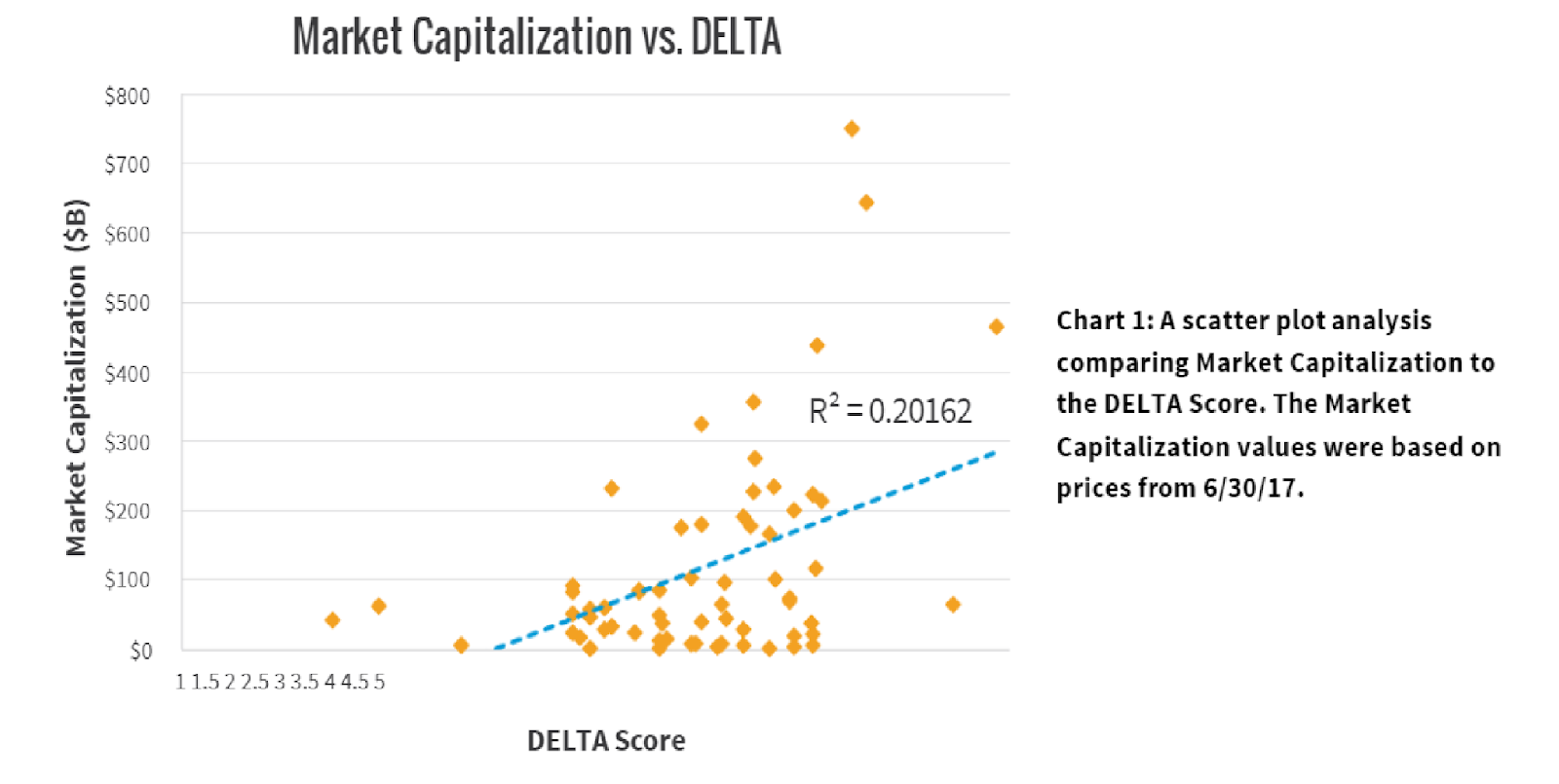
Scatter plot comparing companies’ market capitalization and analytics maturity score according to the DELTA model
As is evident from the plot, companies with higher analytics maturity are more likely to have a higher market capitalization.
The next chart shows the positive correlation between 5- and 10-year operating income and the level of analytics infrastructure in the company.

Bar chart comparing revenue and analytics maturity score according to the DELTA model
Overall, analytics maturity significantly influences the organization’s revenue growth and provides new opportunities.
Types of analytics maturity models
Over the years, data-driven companies created their own analytics maturity models. While the majority of them have remained internal assessment tools, several became generally accepted benchmarks.
Some of the most famous maturity models are:
- Gartner's Maturity Model for Data and Analytics
- Analytics Maturity Quotient Framework
- Data Analytics Maturity Model (DAMM) by Association Analytics
- DELTA Plus Model
- TDWI Analytics Maturity Model
- SAS Analytics Maturity Scorecard
- Web Analytics Maturity Models
Each of these models is described by different authors and has its own features and characteristics. However, their main goal is the same: to help organizations assess their analytics efforts.

Gartner’s analytics maturity model
Characteristics of a great analytics maturity model
Today's competitive market offers a variety of maturity models. Organizations from the analytics sector offer their services to create a maturity model tailored to your business needs and goals.
However, not all models are worth your time. It's common for companies to use maturity models as sales tools to attract customers rather than for measurement purposes.
Let's review the main features that every advanced data analytics maturity model should have.
Genuine assessment results
Today's data and analytics technology vendors create analytics maturity models heavily weighted toward their products. Such models emphasize the need for particular tools and analytics approaches that can't be accomplished without the vendor's software.
So, when choosing an analytics maturity model, make sure that it's balanced and doesn't promote any specific product.
The maturity model shows the path but doesn't get you through it
Companies often expect the maturity model to provide a detailed guide on how to improve their analytical efforts. However, a good analytics maturity model shows you where you need to be instead of getting you there.
It might include some best practices or practical advice, but you'll have to work out a plan on your own.
Metrics and indicators
As a measurement tool by design, a worthy analytics maturity curve should provide a means of assessing your analytics activities, techniques, instruments, and so on.
Frequent Updates
Data analytics is a rapidly changing market with lots of new technologies and job roles appearing frequently. A quality maturity model should always follow industry trends and get timely updates.
Following outdated information will lead to an ineffective analytics roadmap and implementation of legacy technologies.
Douglas Laney, the co-founder of Deloitte Analytics Institute and an award-winning data and analytics specialist, highlighted all of the characteristics of an effective analytics maturity model in his recent article.
Stages of analytics maturity [+inforgraphics]
Analytics maturity models describe the progressive path that analytics take from being just an activity to becoming a critical component of business strategy. We can break down this path into five key steps:
- No analytics. The initial stage of the data analytics maturity model. It may refer to emerging startups or companies that overlooked analytics processes at some point.
- Descriptive analytics. This stage enables an understanding of the reality and current events through the depiction of data. Descriptive analytics answers the question: "What happened?" Analysts use it to measure the effectiveness of the organization's efforts.
- Diagnostic analytics. Diagnostic analytics detects relationships between different variables through the analysis of historical data. It answers the question: "Why did it happen?"
- Predictive analytics. This stage is the frontier of advanced analytics. Predictive analysts create detailed forecasts and foresee the outcomes of actions, events, and trends. With predictive analytics, companies can answer the question: "What will happen in the future?" A predictive system helps organizations make informed decisions by analyzing their previous actions.
- Prescriptive analytics. Prescriptive analytics is the top level of analytics that every company should seek. It implements machine learning algorithms to make recommendations on further actions. In a nutshell, at this stage, you get the answer to the question: "What actions should be taken?"
Each of these stages implies different activities, utilization of various tools, and employment of specialists with diverse skills. In the following section, we'll dive deeper into all stages of analytics maturity.
Ignorance is not bliss
There's a saying that "data is the new oil." However, there are still companies that seem to drive coal-powered cars.
Of course, they have some insights to collect, such as financial data or customer data. The problem of these companies is that they ignore all of the modern technologies and handle everything in an old-fashioned, manual way.
When you're gathering all of your data in a notebook, advanced analytics with fancy predictive models and AI algorithms seems like science fiction.
In such cases, the problem goes deeper than the lack of expertise or resources. Numerous easy-to-learn analytics tools are completely free.
🚀 Read Top 16 Marketing Analytics Tools for 2022 🚀
The starting point here is to explain the value of analytics to the C-suite and push them to take action in this direction.
Descriptive analytics
Descriptive analytics is a form of analysis that handles historical data collection, organization, and visualization. It's one of the initial stages of analytics maturity and focuses on events that have already happened.
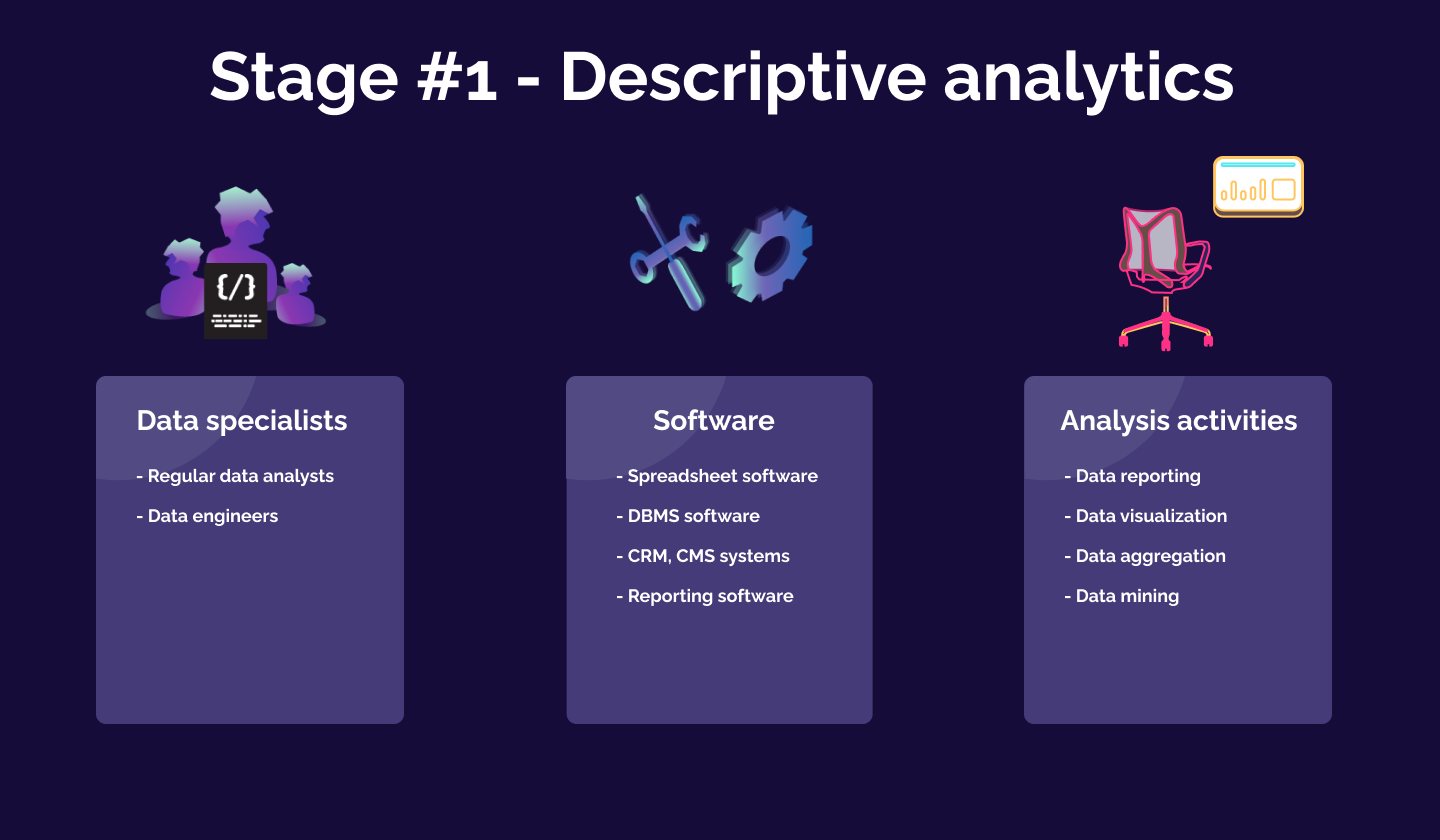
Unlike more advanced forms of analysis, descriptive analytics doesn't make forecasts or give advice based on the collected insights. Its main goal is to dig into the details of what happened.
It helps organizations understand what events led to the success or failure of a particular action and how to achieve more successful outcomes in the future.
The foundation of descriptive analytics
Descriptive analytics has two main methods at its core:
- Data aggregation
- Data mining
Data aggregation is a process of collecting and arranging data in a convenient way for further analysis. Analysts divide insights into meaningful data sets and normalize them to get crystal clear outcomes of the analysis.
🚀 Read What Is Data Aggregation and How It Benefits Businesses? 🚀
The data collected during the aggregation stage is used in the data mining phase, which looks for patterns, trends, and meaning in order to present information in an easy-to-understand format.
Technologies behind descriptive analytics
When it comes to the application of technologies, descriptive analytics falls far behind other stages of analytics maturity.
The main problem of descriptive analytics is the prevalence of manual data operations. Manual data aggregation often results in low quality of the analyzed insights and confusing outcomes of the analysis.
Additionally, descriptive analysts often visualize insights with entry-level tools, like spreadsheets using only pie and bar charts. Without an effective dashboard, they can't get a holistic picture of all of their data.
🚀 Read 34 Charts to Spot Revenue Growth Insights in a Single Dashboard 🚀
Below, we’ve listed several of the main tools used in descriptive analytics:
- Spreadsheet software
- DBMS software (SQL, PostgreSQL)
- CRM, CMS systems
- Reporting software
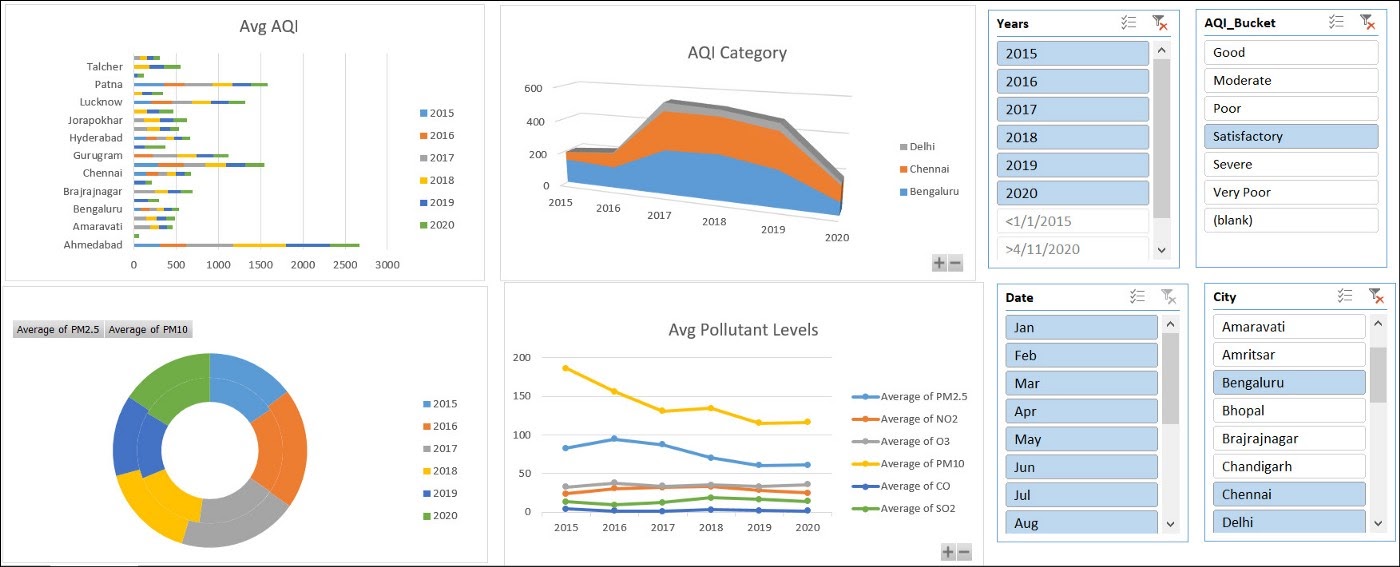
A simple example of charts in Excel
Descriptive analytics use cases
Even though descriptive analytics is the initial stage of any analytics maturity curve, it can deliver actionable business insights if done the right way.
For example, Ashish Pahwa explains how to create a customer profile for different models of the product line with predictive analytics in this case study.
Another case study by CAS shows how descriptive analytics can be used to analyze trends and opportunities in a dynamic market. The results show how to manage the supply chain effectively, efficiently grow the business, and make better decisions.
Overall, descriptive analytics has its pros and cons. It's a good fit for small companies that can't afford fully packed analytics and data science departments. With the right approach, it delivers great insights into the outcomes of the company's ventures.
How to move on to diagnostic analytics
Establish data flow between departments
The first and foremost step to take is to remove data silos between the company's departments. This will make all data accessible to everyone, which is a surefire way to improve analysts' productivity.
For example, marketing analysts rely heavily on sales data. With isolated data infrastructure, marketers spend more time accessing sales by contacting the sales department directly. Implementing a centralized data infrastructure will be beneficial for everyone, from upper management to regular employees.
Upgrade your current tech stack
Continuous data flow is impossible without proper automation. Diagnostic analytics requires companies to set up centralized data warehouses, establish ETL processes, and move on to more advanced visualization tools.
🚀 Read A Beginner's Guide to ETL Processes 🚀
Hire data-driven talent
To create a seamless data infrastructure, you'll have to hire data engineers that will set up and maintain everything along your journey through the analytics maturity curve. Additionally, analysts with data science expertise will extract more actionable insights by applying scientific models instead of simple algebraic methods.
Diagnostic analytics
The next stage of analytics maturity is diagnostic analytics.
It's a logical continuation of descriptive analytics as it allows companies to evaluate the effectiveness of analytics initiatives by comparing data-driven insights with business outcomes.
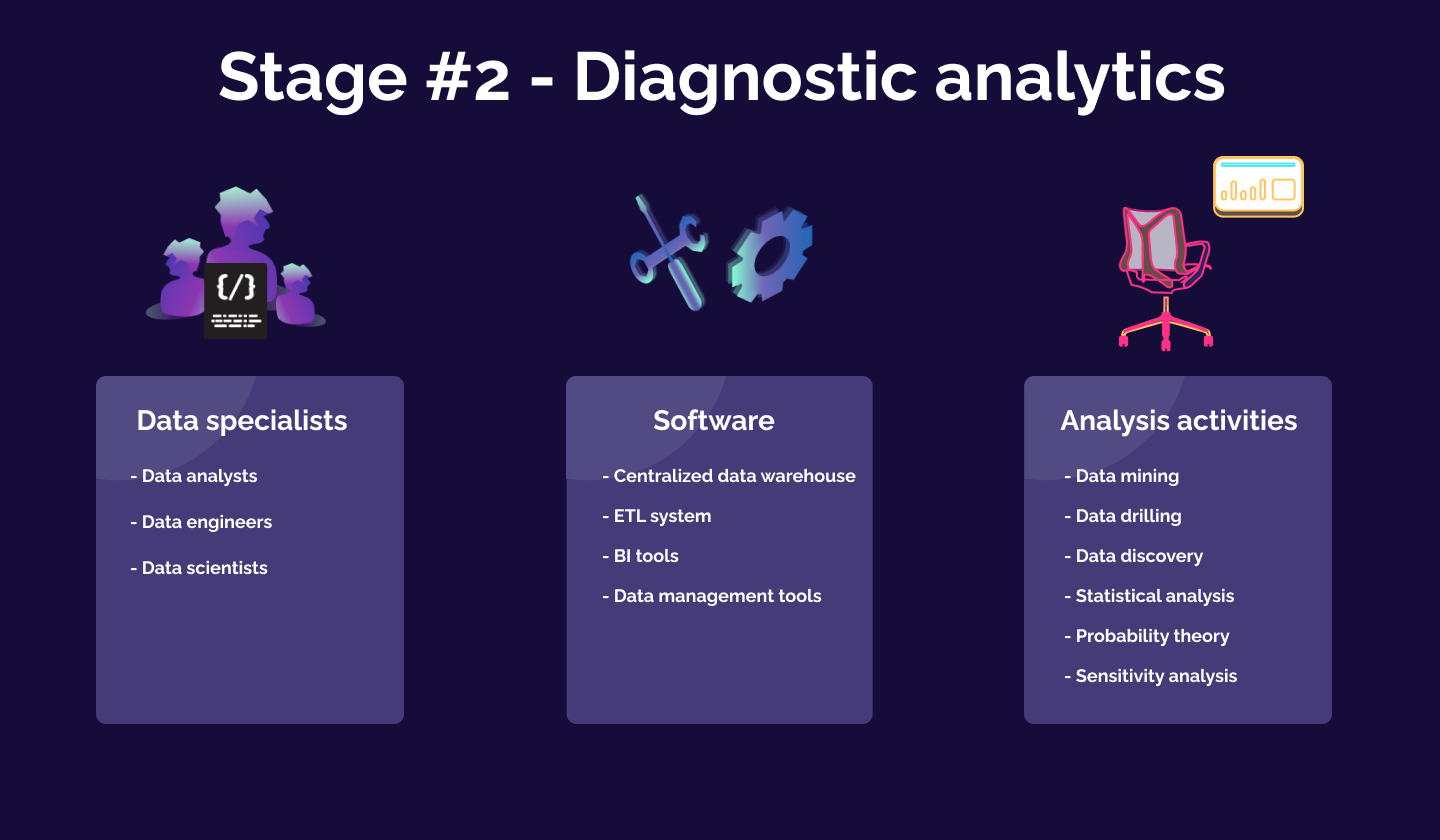
Despite the fact that both diagnostic and descriptive analytics focus on retrospective insights, they answer different questions. Diagnostic analytics shows why and how particular events occurred instead of simply stating that something happened.
That's why this stage requires more complex tools, techniques, and more data to get to the core of the problem.
The foundation of diagnostic analytics
Diagnostic analytics relies on the following techniques to deliver actionable insights:
- Data mining
- Data discovery
- Data drilling
- Drillthrough
- Statistical analysis
- Probability theory
- Sensitivity analysis
As we can see, this stage is a lot more sophisticated in terms of statistical operations and data analytics. That's why organizations need to hire employees with relevant expertise or develop their current analysts' skills.
Technologies behind diagnostic analytics
From a technological perspective, the data architecture becomes more complex and includes advanced tools with new features.
Business intelligence software
Instead of spreadsheets, analysts use business intelligence software, such as Tableau, Looker, etc. These solutions provide unlimited capabilities for building insightful dashboards for various operations (marketing, sales, business analysis, etc.)
🚀 Read Best Data Visualization Tools: Tableau vs Looker vs Power BI 🚀
ETL systems
Things become even more progressive when it comes to data infrastructure. ETL systems come into play to handle the data flow.
With ever-growing amounts of collected data, it becomes physically impossible to gather it manually. That's why analysts need a solution that can automate data aggregation and, at the same time, ensure the highest data granularity.

ETL tools extract data from multiple sources, transform it to a uniform format, and store it in a centralized data warehouse.
These actions significantly reduce the time spent on manual data operations and eliminate the chance of human mistakes while aggregating data. Additionally, ETL systems may include various helpful features.
For example, Improvado's marketing ETL platform automatically extracts data from 500+ sources and aligns metrics' naming conventions with its MCDM algorithm.
🚀 Read 14 Best ETL Tools For Enterprise Businesses 🚀
Centralized data warehouse
A centralized data warehouse is another necessity when walking the path of analytics perfection. Analysts need a single source of truth for all the data accumulated by the company.
With large amounts of data, storing data in spreadsheets is no longer an option. The more insights you gather, the more time it takes to update the sheet. Hence, analysts' productivity declines.
A data warehouse simplifies the access to insights and accelerates the work with large data sets. Moreover, it helps to map data between different departments.

Data warehouse architecture
You can set up an on-premise data warehouse with technologies such as MySQL or PostgreSQL. However, today's market offers a variety of third-party data warehousing tools, such as BigQuery, Amazon S3, Redshift, and others.
🚀 Read Top 15 Data Warehousing Tools 🚀
Some ETL tools offer managed warehouse services. For instance, Improvado can store all your marketing data in its custom warehouse. Such an approach is useful because you don't have to build a warehouse from scratch. What's more, you can use a single tool for all your data infrastructure needs, thus reducing the time required to learn new instruments.
Diagnostic analytics use cases
Numerous companies use diagnostic analytics to accomplish business goals and analyze the outcomes of particular events.
For example, Improvado helped Hyperconnect integrate marketing data into its data infrastructure and achieve a deeper view of its marketing metrics and campaign results. With a marketing ETL software, Hyperconnect creates marketing reports faster and predicts the outcomes of marketing strategies more precisely.
Diagnostic analytics is put to good use in the healthcare sector. Massachusetts Institute of Technology developed an algorithm that finds differences between medical scans, such as MRIs. With the implementation of data analysis and machine learning techniques, the algorithm can map all pixels on the image in less than a second if using a GPU. This algorithm helps physicians examine more patients and identify issues more precisely.
How to move on to predictive analytics
Prioritizing machine learning
Analysts rely on machine learning (ML) algorithms when making decisions, predicting future events and outcomes. That's why data scientists and software engineers have to train new ML models, integrate ML methods into the existing data infrastructure, and search for applications for machine learning in analytics activities.
Maintaining data-driven culture
Predictive analytics requires effort from all of the company's employees, not only data scientists and analysts. With an accessible data infrastructure, every specialist can make use of gathered insights. Thus, you have to invest in teaching your employees to query data, use BI tools, and analyze the outcomes of their actions by themselves.
With this approach, data specialists will focus on more important tasks than creating hundreds of different queries for each department. On the other hand, non-technical specialists will also benefit because they can experiment with data and see detailed results of their work without relying on anyone.
🚀 Read Data-driven Marketing 101🚀
Integration of advanced analytics software
Ensure that your employees have access to predictive analytics software suitable for their scope of activities. For example, marketing and financial employees work with different insights. Thus, they'll need narrowly focused tools tailored to their business operations. Such flexibility in the choice of instruments provides more analytics opportunities and accelerates the workflow.
Predictive analytics
Predictive analytics is the starting point of advanced analytics. It involves statistical algorithms, modeling, and machine learning to forecast the outcomes of the planned initiatives.

The main goal of this stage of analytics maturity is to search for patterns that occurred in the past and use them to make conclusions and produce precise forecasts. Predictive analytics learns from gathered data to predict the possible behavior of customers and make better decisions.
In the predictive analytics stage, employees begin to use self-serve platforms to track statistics and make predictions by themselves. That's why the overall data infrastructure becomes more sophisticated from both technical and organizational perspectives.
🚀 Read Predictive Analytics in Performance Marketing: Why, What For, and How 🚀
The foundation for predictive analytics
At this stage, analysts apply more complex tools and data processing techniques. Here are some of the technologies that deliver precise predictions and forecasts:
- Machine Learning
- Big Data
- Artificial Intelligence
Data specialists' responsibilities have changed drastically. Previously, they were responsible for setting up dashboards, managing data pipelines, and handling analytics. However, due to the automation of analytics, all team members can make predictions and conduct analytics by themselves.
Hence, the data team becomes responsible for the management of data flows and the implementation of new technologies and forecasting models.
In a recent article, Ryan Gross researched numerous AI use cases for both predictive and prescriptive analytics. His research states that predictive analytics generates the most revenue for companies ($1.2 trillion). Hence, companies have to push forward toward this stage of analytics maturity to stay on top of the trend.

Technologies behind predictive analytics
With the integration of automated pipelines into your data ecosystem, insights will flow from all possible channels. Marketing, sales, website analytics, and other kinds of data will be stored in your data warehouse.
To extract actionable insights from a continuous flow of data, you'll need Big Data-related technologies, such as distributed computing and parallel processing, to analyze gigantic data sets on dozens of machines at the same time.
🚀 Read How Big Data in Marketing Shapes the Future of Advertising 🚀
Besides, it becomes impossible to use a universal machine learning algorithm and train it for different situations with this type of data volume. Instead, your data team will have to develop a machine learning pipeline that automates the learning workflow, creates new learning models, trains them, and handles other kinds of ML management activities.
Tools like Google ML Kit, TensorFlow, or SageMaker can serve as a basis for your ML pipeline.
Finally, you have to take care of the following points:
- Improve your current hardware
- Ensure f data security and integrity
- Upgrade your network and data warehouse
Predictive analytics use cases
Predictive analytics can be used in absolutely any industry to predict market trends, forecast revenue growth, foresee increases in prices of particular assets, and so on.
For example, real estate companies actively use predictive analytics to stay ahead of the market. HouseCanary uses predictive analytics to provide clients with forecasts and make them more confident in their investments.
Companies can predict the outcomes of their marketing campaigns and drive more leads with predictive analytics. In this post, we explained how to increase sales via e-commerce platforms with the help of predictive analytics in performance marketing.
The supply chain is another sector where predictive analytics improves the workflow. It helps to reduce operational costs, warehouse downtime, and accelerate the delivery of cargo between storage solutions.
How to move on to prescriptive analytics
Improved decision-making processes
Since prescriptive analytics helps to find the right decision to the problem, it should clearly understand the subject of analysis and output a proper decision as fast as possible. That's why businesses should invest in the automation of decision-making processes and use analytics as the foundation of their further innovations and company culture.
Take care of data quality assurance
Even the most advanced systems may sometimes malfunction. However, when these systems give advice and make decisions, the results of their work should always be verified. If discrepant data falls into the pipeline, it may produce misleading results and disrupt the overall analytics workflow. So, quality assurance becomes an integral part of a healthy data ecosystem.
Prescriptive analytics
Finally, we’ve reached the ideal state of analytics maturity. Unlike predictive modeling, prescriptive analytics suggests the best possible actions for each situation based on historical insights, real-time data, and information about the outcomes of previous decisions.
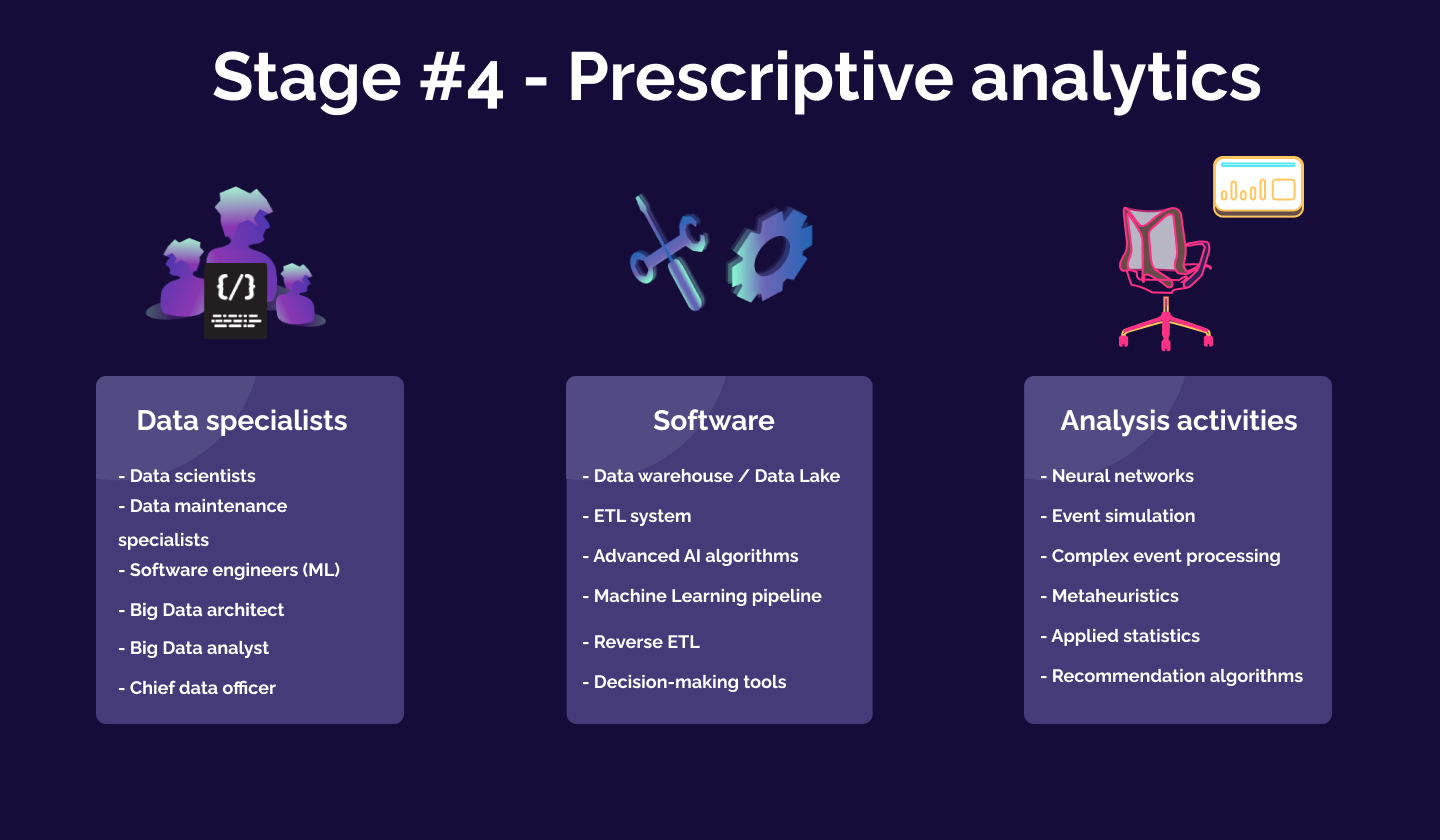
At this stage, the company's development vector largely depends on analytics and data specialists. C-suite and business development representatives will make their moves and build strategies based on the suggestions produced by the analytics ecosystem.
The foundation for prescriptive analytics
As well as the predictive stage, prescriptive analytics completely relies on Big Data. However, it uses even more complicated statistical approaches and models, such as:
- Event simulation
- Complex event processing
- Heuristics
- Recommendation algorithms and engines
- Neural networks
However, machine learning and artificial intelligence remain the two main concepts that power prescriptive analytics.
The core idea behind all of these technologies and approaches is to make prescriptive models more accurate, create a large library of knowledge, and deliver meaningful results in less time.
Technologies behind prescriptive analytics
Companies that reach the ideal state of analytics apply various technologies and software solutions to analyze data.
RapidMiner is one of the famous prescriptive analytics tools. It combines AI and a powerful graphical interface to help users create, maintain, and deliver predictive analytics. It also supports custom scripts in multiple languages.
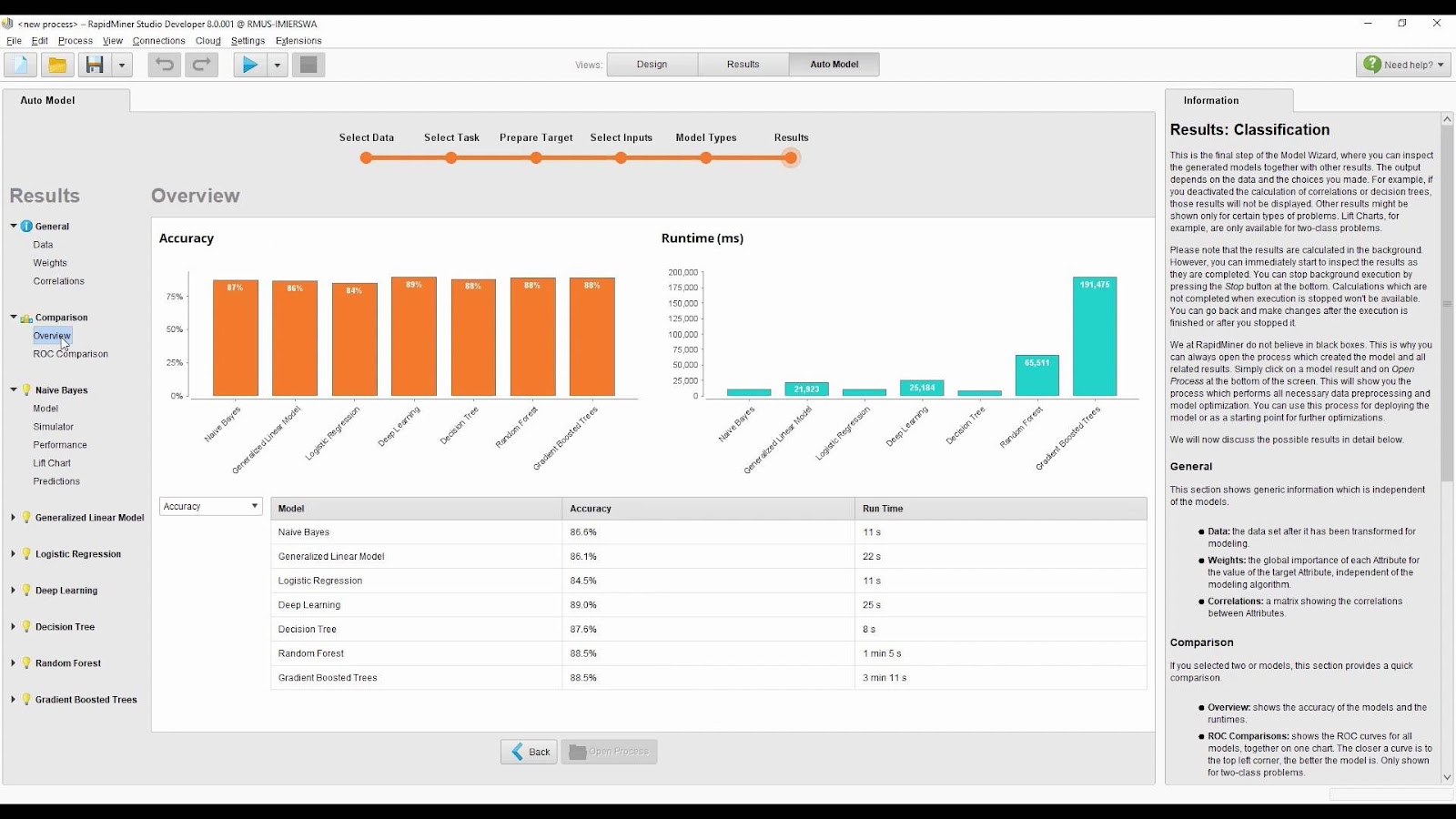
RapidMiner analytics workflow
Birst is a web-based BI and prescriptive analytics tool that merges data across distributed teams, suggests further actions, and helps users to make more informed decisions. The tool focuses on building trust with data gathered from multiple sources within the enterprise.
The list of tools goes on. The previously mentioned ETL systems, ML pipelines, data warehouses, and other tools are still in use, and they play a vital role in the success of the prescriptive analytics model.
🚀 Read Top 10 Prescriptive Analytics Tools 🚀
Prescriptive analytics use cases
Some of the most obvious use cases for prescriptive analytics are in the sales and marketing sectors. Prescriptive analytics can be useful in the precise identification of target groups, recommendation systems, adjustment of the sales funnel, and many other use cases.
🚀 Read Guide to Effective Product Recommendation in eCommerce🚀
For example, Pranov Mishra from Analytics Vidhya explained how to improve a company’s customer retention rate with recommendations from prescriptive analytics algorithms.
This analytics approach can also be applied in travel and transportation. The InterContinental Hotel Group uses 650 variables to identify the best product/price combination for each customer.
What's more, prescriptive analytics help to manage risks and reduce the chances of making wrong decisions.
What's next?
Although you've reached analytics perfection, there's still room for growth. You must continue to maintain your data ecosystem and work on data safety and integrity. According to scientific researchers, heterogeneity of the data and security issues are two of the most challenging issues in Big Data today.
What's more, you should experiment with data more often. What's the point of building an advanced analytics infrastructure if you don't test your data in different ways. However, you need to train your employees and hire more data specialists to carry out more experiments.
Even though your trip through the analytics maturity model is over, there are still many ways to improve your analytics and boost your company's growth.
How to bring your company to analytics maturity
Analytics maturity models don't provide you with clear steps on the path to analytics maturity. They only show you where you should be.
But don't worry; we've got you covered. We'll give you some tips and explain the steps to take to build a top-notch analytics system in your company.
1. Pick the right analytics maturity model (or build one for yourself)
We have already discussed the most popular maturity models above. You can pick one of them while also keeping your business objectives and industry specificities in mind.
If none of them suits your business, you can build a custom analytics maturity model based on the best examples from Gartner or SAS. However, if you're not an expert analyst, it's better to entrust this task to the chief data officer or data architect. Without the required expertise, you could guide your company in the wrong direction.
2. Assess your current state of analytics
Find out what data is currently used across the organization, where it comes from, what tools are already used to handle it, and who works with data in your company.
This will give you a solid foundation before you integrate new tools and new analytical approaches.
3. Conduct research on all of the possible data sources you're going to use
You can often reduce the time cost for data integration by simply knowing what data sources you're going to use. The thing is, every time you need to add a new source, your data analysts or engineers will have to deal with its API or even create a custom one. This takes time and distracts employees from their direct tasks.
4. Ask your data straightforward questions
Identify the metrics you're going to follow. Decide what exactly you need to derive from your data and find the metrics that will show you this information. Don't prioritize quantitative metrics. Instead, focus on metrics that explain "why" something happened. This approach will serve you well when moving from descriptive to diagnostic analytics.
5. Arrange a centralized data infrastructure inside your company
With data silos and isolated data across departments, analytics won't work out. Providing each employee with equal access to data should be your top priority. In the future, they will use it to analyze their efforts and predict the outcomes of their initiatives without the help of data specialists.
6. Apply new technologies and train your staff to use them
As has been made clear, each stage of analytics maturity implies the integration of new tools and analysis approaches. BI tools, ETL platforms, ML pipelines, and other instruments are a necessity both for analysts and regular employees. So, don't ignore the integration of new instruments into your existing infrastructure.
Rock Your Marketing Analytics Maturity Curve With Improvado
With the right approach to aggregation and analysis, your data will provide you with a competitive edge and growth strategy. It allows you to dive deeper into customer behavior, identify new opportunities, and react to market trends faster.
When thinking of analytics integration across your company, marketing is one of the activities you should focus on. Email campaigns, content marketing, social media, paid ads, and other channels generate large volumes of heterogeneous data that is hard to aggregate manually.
A marketing ETL system is a must-have solution to organize insights and make use of your advertising and sales data. Improvado aggregates data from across 500+ data sources, normalizes it, and stores it in a data warehouse. Analysts can connect any visualization tool to build insightful dashboards and keep an eye on real-time changes in the organization's marketing performance.

Improvado’s analytics maturity model
With all data in one place, analysts can effectively adjust campaigns and track results with ease. Schedule a call to learn how Improvado can speed up your growth and lead your company to analytics maturity. 👇
.png)
.jpeg)



.png)
